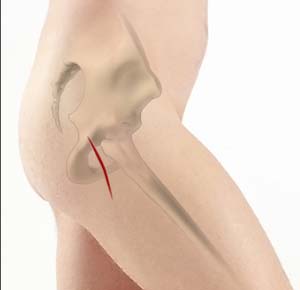Dr. Makda provided EXCEPTIONAL care to my father for his knee replacements.
Dr. Makda provided EXCEPTIONAL care to my father for his knee replacements. His attention to his patients and willingness to explain the treatment pla...

Posterior hip replacement is a minimally invasive hip surgery performed to replace the hip joint. It is also referred to as muscle sparing surgery because no muscles are cut to access the hip joint, enabling a quicker return to normal activity.
The posterior approach is traditionally the most common approach used to perform total hip replacement.
In posterior hip replacement, the surgeon makes the hip incision at the back of the hip close to the buttocks. The incision is placed so the abductor muscles, the major walking muscles, are not cut.
Hip replacement is indicated in patients with arthritis of the hip joint.
Arthritis is a condition in which the articular cartilage that covers the joint surface is damaged or worn out causing pain and inflammation. Some of the causes of arthritis include:
Patients with arthritis may have a thinner articular cartilage lining, a narrowed joint space, presence of bone spurs or excessive bone growth around the edges of the hip joint. Because of all these factors arthritis patients can experience pain, stiffness, and restricted movements.
Your doctor will evaluate arthritis based on the characteristic symptoms and diagnostic tests. Your orthopedic surgeon will perform a physical examination; order X-rays and other scans, and some blood tests to rule out any other conditions that may cause similar symptoms.
Posterior hip replacement surgery involves the following steps:
The advantages of the muscle sparing posterior approach include:
All surgeries carry an element of risk whether it is related to the anesthesia or the procedure itself. Risks and complications are rare but can occur. Below is a list of complications that can occur following any hip replacement procedure:
Dr. Makda provided EXCEPTIONAL care to my father for his knee replacements.
Dr. Makda provided EXCEPTIONAL care to my father for his knee replacements. His attention to his patients and willingness to explain the treatment pla...
I had needed knee replacements for quite awhile.
I had needed knee replacements for quite awhile. I even saw other doctors about it but never moved forward as I realized now it all was never explaine...
Dr. Makda is wonderful. He is kind, very knowledgeable and offers different types of recovery for knee problems. After 3 visits I was released from ca...
My left knee was replaced in the hands of Dr Makda last July
My left knee was replaced in the hands of Dr Makda last July. Now my right hip in 2 weeks (mid April 2019).
All went as expected. Have to do all the therapy if you want to recover fast.
All went as expected. Have to do all the therapy if you want to recover fast. Very happy with my new left knee.
100 Village Green Drive
Suite 120
Lincolnshire, IL 60069